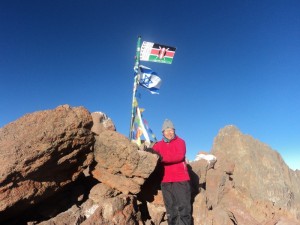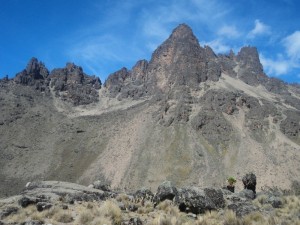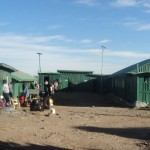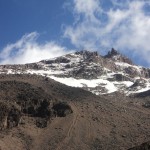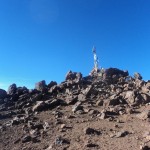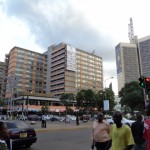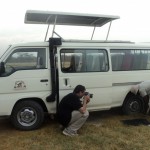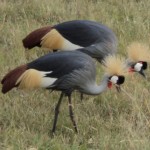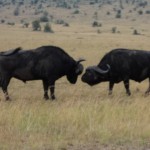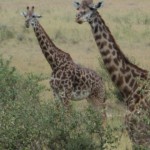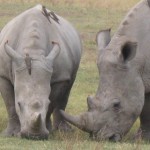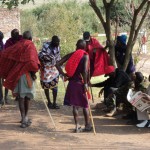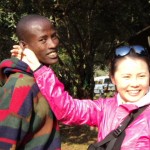I travelled to East Africa after my trip to Ethiopia in February. In Kenya, I reached Point Lenana (4985m), Mt Kenya and spent five lovely days in the Nakuru National Park and Maasai Mara National Park to see wildlife.
Kenya
Area: 582,650 square kilometres
Population: over 30 million (est). The population is highly heterogeneous. The major ethnic groups include the Kikuyu (comprising 22% of the population), the Luhya (14%), the Luo (13%), the Kalenjin (12%) and the Kanmba (11%). English and Kiswahili are the two official languages.
GDP: US$29.38 billion (2009); GDP per capita:US$738 (2009); GDP per capita (PPP): US$1,600 (2010 est)
Tour of 3 Top National Parks in Kenya
February 6 – 7: Nairobi
I arrived in Nairobi with bandages on my right wrist. The back of both legs were also painful as a result of sunburn. I had to change my original plan which included a 5-day Mt Kenya trek followed by an 8-day Kilimanjaro (Kili) trek. After discussing with Chris, the tour operator in Nairobi, we agreed I should take a rest before commencing the Mt Kenya trek. If the wounds healed properly, I could go on to the Kili trek as scheduled.
Mt Kenya Trek (February 8 – 12)
February 8: Nairobi – Nanyuki (by car)
I had a comfortable ride in a saloon car and was met by Daniel, my guide in Nanyuki. I checked the wound on my wrist which should no signs of infection and applied cream on my legs. Things seemed to be under control and I decided to commence the trek the next day.
February 9-12 – Mt. Kenya National Park
Mt Kenya National Park is a World Heritage Site. Mt Kenya, located on the equator, is the second highest mountain in Africa. It is a stratovolcano created some 3 million years ago after the opening of the East African rift and was covered by an ice cap for thousands of years. This has resulted in much eroded slopes and numerous valleys radiating from the centre. Many species are endemic to Mt Kenya such as the giant lobelias and senecios. Its three highest peaks are Batian (Alt 5,199m), Nelion (Alt 5,188m) and Point Lenana (Alt 4,985m). The first two require technical climbing. Hence Pt Lenana is the destination for some 20,000 visitors to the park.
I set off with Daniel and a porter-cum-cook after having purchased some vegetable and food. We arrived at the South Gate (2600m), which is the starting point of the Sirimon route and took off at 1 pm after a picnic lunch. As my pains on my legs have mostly gone and I wear loose pants, I can walk without problem. The 9km-trek on a dirt road is easy but boring. I wish the Park Authority would develop an alternate scenic walking trail for trekkers through the beautiful forest. I reached the Old Moses Camp (3200m) just before 4pm.
The walk on the second day is long i.e. 16km. We set off around 7:30am. The scenery upon entering the Mackinder Valley is most beautiful and impressive with giant lobelias, senecios, running streams, escarpments and Mt Kenya as the backdrop. I reached the Shipton Camp (4200m) around 3pm.
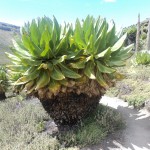 |
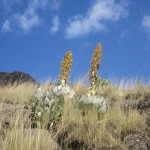 |
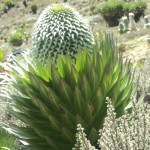 |
I lay on the grass sunbathing and appreciating the views of Mt Kenya. I had an early dinner at 7pm but I could not eat. This is a signal of onset of altitude sickness as I had no time for acclimatisation. I could not sleep as a dozen of inconsiderate trekkers arrived late and talked loudly and move around noisily till midnight.
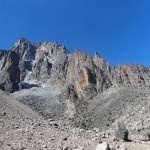 |
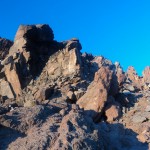 |
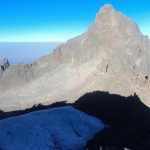 |
The third day (February 11) is a tough day. I got up at 2am with a headache and vomited after having a cup of tea. These are all signs of altitude sickness. But as my legs were still strong, I decided to go on. But it’s a most difficult climb for me as the eroded slope is very steep and slippery with loose rocks. When I vomited for the third time, Daniel looked concerned and suggested me return to the camp. I felt strong enough to carry on. Daniel looked miserable and was cross to find my dim headlight. After a while, we worked out a practical way to continue with the ascent in the dark. Daniel moved ahead and found a safe path first. He then turned his headlight in my direction to enable me to follow his steps. In this way, I moved slowly but steadily and had more breathing time! Finally I reached the ridge around 6:30am and was met by a magical daybreak.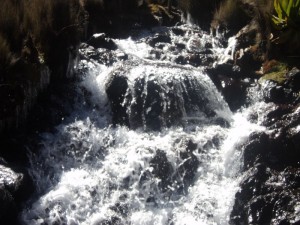
The final climb to Pt Lenana is difficult as the path is steep and very slippery. I had to pull myself up through rocks at several places. Daniel looked sick and was least helpful. He disappeared for a while without a word and I carried my backpack all the way. I pulled myself together and finally reached the top at 7:30am. Daniel did not carry a flask (trekkers are normally given a hot drink after summiting). Fortunately, I had a small thermo flask and had some hot water before heading back to the Shipton Camp. As I was the last one to arrive at the top, the place was almost deserted and I enjoyed the tranquility and fantastic views of the other two peaks (Batian and Nelion) and the expansive mountain ranges near and afar!
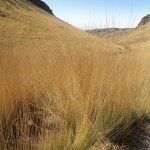 The walk to the Shipton Camp is equally nerve-breaking. As I have problems with my knees, I find walking downhill difficult. I have to use walking poles which help lessen the impact on the knees. I tumbled several times. When I almost fell flat on my head, Daniel realised my problem and suggested me give him my hand so that I could walk more steadily. We finally arrived at the Camp around 10am. I was totally exhausted and went to bed. After a light brunch, I followed the same path to the Old Moses Camp. Half way to the Old Moses Camp, I started to feel sick and walked as slow as a snail. The 21km-trek normally can be done in 9-10 hours. But I spend some 12 hours and reach the camp at 7pm. I had no appetite and went to bed. What a long and trying day!
The walk to the Shipton Camp is equally nerve-breaking. As I have problems with my knees, I find walking downhill difficult. I have to use walking poles which help lessen the impact on the knees. I tumbled several times. When I almost fell flat on my head, Daniel realised my problem and suggested me give him my hand so that I could walk more steadily. We finally arrived at the Camp around 10am. I was totally exhausted and went to bed. After a light brunch, I followed the same path to the Old Moses Camp. Half way to the Old Moses Camp, I started to feel sick and walked as slow as a snail. The 21km-trek normally can be done in 9-10 hours. But I spend some 12 hours and reach the camp at 7pm. I had no appetite and went to bed. What a long and trying day!
On my way to the Old Moses Camp, my mind was centred on two problems. First, I discovered infection of the wound on my wrist. I must consult a doctor in Nairobi before deciding whether I should continue with my trip. A camping trek in Mt Kili with worse hygienic condition is not desirable. Second, if I cannot sleep well, I am an easy victim of altitude sickness. I had the same problem on my Mt Kili trek in August 2010 and on the hike to Pt Lenana. With my present condition, I would be totally unfit for a strenuous trek. As I have already paid a deposit for the Mt Kili trek, I have to find a viable option as the tour company is most unlikely to refund me. Chris of the tour company is a nice and sympathetic person and suggested to discuss options on my return to Nairobi. A good sleep makes a lot of difference. I recovered and felt hungry for the first time the following day and departed at 8am after a big breakfast. I reached the South Gate at 10:30am and completed my Mt Kenya trek.
A trekker is expected to give a tip at the end of the trek. Daniel is a sulky person and has not been helpful or informative about the flora and fauna in the park. His support especially during the ascent to Pt Lenana is far from satisfactory. Daniel was very upset when he received the tip. He claimed that his past customers have given him USD100 to 300 as tips and complained about the amount he has received from tour operators. I believe in responsible and sustainable tourism and regard myself as a responsible traveller. The amount a customer pays should be fair and just to all parties concerned i.e. the customer and the service provider (i.e. the agent, the guide, the porter etc). In my view, I have paid a fair amount to Chris and the amount he gives to Daniel is a matter between two of them. In any case, I had left my money in the safe in Nairobi and could only give him whatever I had with me! I do not think Daniel deserved a big tip given his poor service and attitude. But if a small amount that I can spares, can make a difference to their life and make them happier, I am delighted to do so.
February 12 – 13: Nairobi
I arrived in Nairobi around 2pm and waited in the hotel for Chris the whole day. He finally turned up at 11pm (perhaps, the Kenyans live on a different time zone!). After a long discussion, we worked out a revised travel plan and payment: I would visit Maasai Mara and the Nakuru National Park. If I am fit without further infection on my wrist, I can do the Mt Meru trek. To play safe, I went to the clinic opposite the hotel to check the condition of my wound. I spent over an hour in the clinic waiting for a doctor, taking a blood test, making payment and buying antibiotics. When the doctor first saw the wound, he said ‘this is the way people commit suicide’. I had to explain what had happened in Zanzibar. The blood test result indicated that the infection was not serious. The doctor considered it safe for me to go on a safari trip as long as I could keep the wound clean. The total bill came up to about USD50.
I had a leisure time in Nairobi and visited the National Museum located in a nice park. The display in the museum is good with information. There is an excellent display of a few 2.5 to 1 million – year – old skeletons.
February 14-17- Safari
Nakuru National Park with an area of 1880 square kilometres is famous for its flamingoes and birdlife. Tony, a Canadian of Italian descent, also signed up for this trip. We set off after 11 am on February 14 and arrived at the Park at 4pm. During the sunset game drive, I saw plenty of flamingoes, storks, zebras, baboons and several rhinoceros.
Our self-contained bungalow inside the park has very basic facilities (two bedrooms, a kitchen, a toilet without water, a sitting cum dining room). We also had to prepare our own dinner as there’s no restaurant nearby. I prepared chicken and soup and Tony spent two hours on a pasta dish. The driver had to take the jeep for repair. Three strangers had a dinner on Valentine Day in the middle of nowhere. Strange but funny!
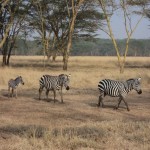 We had a morning game drive before leaving the park the following day. The driver said he heard lion roaring just before daybreak. For a city girl, I can hardly tell the difference of the sound from one animal to another! Though I did not see a lion, I enjoyed the morning mist and fresh air. I watched sunrise and lovely reflections of birds by the lake. The driver dropped me at the meeting point where I would join another group for a safari in Maasai Mara National Park from February 15 to 17.
We had a morning game drive before leaving the park the following day. The driver said he heard lion roaring just before daybreak. For a city girl, I can hardly tell the difference of the sound from one animal to another! Though I did not see a lion, I enjoyed the morning mist and fresh air. I watched sunrise and lovely reflections of birds by the lake. The driver dropped me at the meeting point where I would join another group for a safari in Maasai Mara National Park from February 15 to 17.
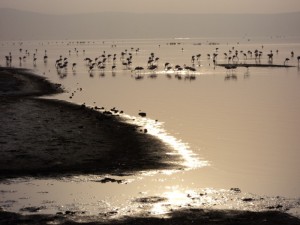 |
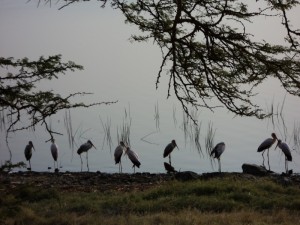 |
Maasai Mara National Park with a total area of 1,500 square kilometres, is world famous for its wildlife, sighting of the ‘Big Five’ (lion, leopard, African elephant, African buffalo and black rhinoceros) and the ‘Great Migration’ where millions of wildebeests, topis etc cross the Mara River in the summer months. The entrance fee for foreigners is US$60 a day while the locals pay 1000 shillings. Most tour operators from Nairobi offer a 3-day package i.e. arrival at the park in the afternoon followed by a sunset drive on the first day, a full-day drive on the second day and a sunrise game drive before returning to Nairobi on the third day.
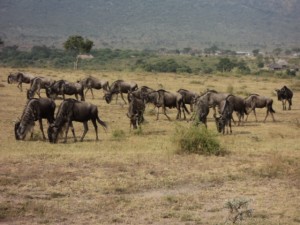 |
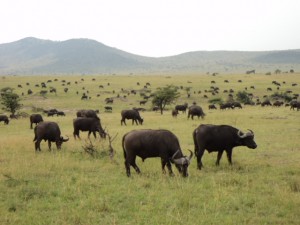 |
|
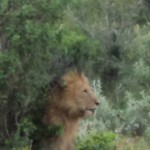 The ‘Big Five’ is a star attraction in Kenya. There were four other tourists on this tour i.e. a Canadian teacher who is on a one-year-round-the-world-trip, two young Japanese girls and a German student. We arrived at our camp located just outside the gate at 3:30pm. I had a self-contained tent which has two beds, light, toilet and shower. The dining hall is nice and the food is good. During our sunset game drive, I saw three lions, two African cranes (which is the national bird of Uganda), many wildebeests, Masai giraffes, antelopes, impalas, buffalos, zebras, elephants, warogs, hyenas, jackals etc. The scenery is beautiful with tall grass, rolling hills and bush land. Tourists are all travelling in jeeps or vans with open rooftop. As the vehicles are painted in white, I call them ‘white elephants’. I am upset to see a few aggressive drivers getting too close to the lions. We should not disturb the animals. In any case, the expansive land and beautiful natural scenery is unforgettable. I appreciate the sense of freedom and wilderness which is spoilt by the white elephants!
The ‘Big Five’ is a star attraction in Kenya. There were four other tourists on this tour i.e. a Canadian teacher who is on a one-year-round-the-world-trip, two young Japanese girls and a German student. We arrived at our camp located just outside the gate at 3:30pm. I had a self-contained tent which has two beds, light, toilet and shower. The dining hall is nice and the food is good. During our sunset game drive, I saw three lions, two African cranes (which is the national bird of Uganda), many wildebeests, Masai giraffes, antelopes, impalas, buffalos, zebras, elephants, warogs, hyenas, jackals etc. The scenery is beautiful with tall grass, rolling hills and bush land. Tourists are all travelling in jeeps or vans with open rooftop. As the vehicles are painted in white, I call them ‘white elephants’. I am upset to see a few aggressive drivers getting too close to the lions. We should not disturb the animals. In any case, the expansive land and beautiful natural scenery is unforgettable. I appreciate the sense of freedom and wilderness which is spoilt by the white elephants!
We had a full-day game drive on February 16 setting of at 7:30am on February 16. We no longer get excited at the sights of lions, giraffes and elephants. At one of the spots, we saw at least a dozen of lionesses and cubs lying in the sun. We had lunch close to the Mara River which is the spot for the annual ‘Great Migration’. There are also plenty of hippopotamus and Nile crocodiles in the river.
There are three unforgettable scenes of the day. First, we followed and watched a lion dragging a half-eaten calf to a bush for hiding purpose. The lion was exhausted panting loudly. Having hidden his treasure, he walked in front of a jeep to rest under another bush. Second, we spotted three cheetahs (a mom and her two cubs) under a tree. Cheetahs are beautiful and look so serene. Third, we saw a pair of old lions sleeping peacefully under a big tree in the late afternoon. The lion lying on his back had its legs wide open (like human beings!). They snored and were oblivious of the troubled world around them.
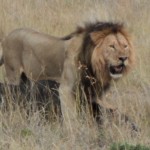 |
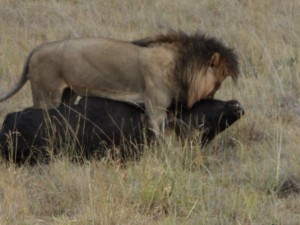 |
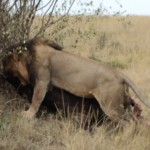 |
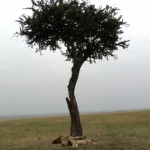 |
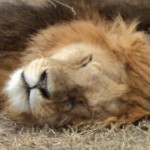 |
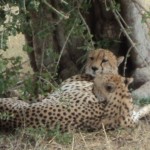 |
We also visited a Maasai village. Maasai people are semi-nomadic. We paid an entrance fee of US$20 each which goes to a community fund for supporting community projects and students to study in high school in town. We were greeted by a group of young men performing a traditional dance. Our guide, a son of the chief of the village, speaks good English. His father has four wives and some 25 children. The village is inhabited by over 200 people of the same clan and all the animals are kept in the open ground in the centre of the village in the evening. We visited his house which is made of dung and mud with two rooms and a sitting area with a fire. He has three young children. His herd is kept in a shad at the entrance of the house. Before leaving, we visited a community school which has a satellite dish and solar panel installed with donation from an American who visited the school last year. With these devices, the students can use computer and get connected with the cyber world. Facilities are very basic and there are some 60 children in each class. Children from poor families are provided with a free meal. The school is in need of money to provide books and free meal. I gladly made a donation for education purposes.
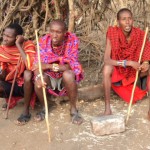 |
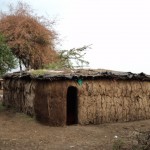 |
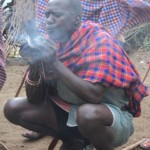 |
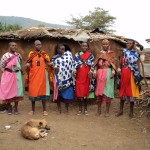 |
The Maasai people are keen to keep up their tradition. I enjoy the village tour and am happy to pay the entrance fee as this helps preserving their way of life and bringing some necessary improvements for the community. No one in the village pays attention to visitors or asks for photo money. This is a big contrast to my experience in Ethiopia. I do not mind paying an entrance fee to visit these villages as long as the money collected is used for a good cause. However I do not like to pay photo money and treat the tribal people as commodities. I believe this is something the tribes in Ethiopia can learn from the Maasai community
We had our last game drive at 5am on February 17. By then we have seen all the Big Five except the leopard and no longer get excited easily. Though the novelty has gone, I still find the drive wonderful. It is a blessing to be able to see sunrise in an unspoilt natural setting.
We had a long drive back to Nairobi and took Chris out for dinner in a Chinese restaurant. I shared my views on tourism development in general and problems with Daniel as a trekking guide and problem with mass tourism in particular. I told him about my enjoyable trekking experience in Nepal and suggested what can be done to improve the trekking experience for his customers. Chris is energetic and anxious to have customers’ feedback. I hope he finds my suggestions useful.
Remarks
This is my first visit to Kenya (though I was in transit last August after my failed attempt to reach Mt Kili). I have made the right decision and cancelled the Mt Kili trek thus spending more time in Kenya. As a result, I spent a total of eight days in three national parks.
I am particularly pleased to reach Pt Lenana given the wound with infection on my right wrist, the difficult, steep and slippery ascent and the altitude sickness problem. Bearing in mind that I have been unable to walk on several occasions and have often experienced crucifying pain after strenuous walk downhill, I cannot believe I have completed the Mt Kenya trek without post-trek pains. Perhaps, I am fitter or my muscles are stronger today. Anyway, I treasure every moment that I move around freely (though slowly!) to discover this wonderful world.
I enjoy Maasai Mara. Though I have seen many animals and wildlife in the Arctic and Antarctica region, South Africa, Namibia, Uganda and South Africa before coming to Kenya, I enjoy my game drives just the same. I have never seen so many lions and giraffes in my life. It is also thrilling to see my first three cheetahs. I hope to return one day to see the Great Migration at Mara River and find a leopard. However, I am concerned about the reckless manner of some jeep drivers who drive too close to the animals in order to enable the tourists to get a good picture. This is unacceptable behaviour. The Park authority should impose stricter distance requirements on the jeep drivers without disturbing the animals.
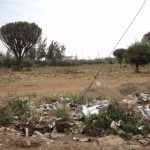 I find the areas I have been visited in Kenya fairly developed (by African standards) and pleasant. Nairobi, the capital, is a vibrant business and commercial centre. The main highways are fairly good and a super highway to the north with 10 lanes close to Nairobi is under construction with China’s assistance. I have been to a polyclinic twice and several pharmacies many times. It is obvious that the medical services are more costly and of much higher standard than Ethiopia. I have seen many boarding schools along the route to the Nakuru National Park. According to the driver, the country places high priority on education and the country has made some improvements and enjoys freedom of press and speech though corruption is still a problem.
I find the areas I have been visited in Kenya fairly developed (by African standards) and pleasant. Nairobi, the capital, is a vibrant business and commercial centre. The main highways are fairly good and a super highway to the north with 10 lanes close to Nairobi is under construction with China’s assistance. I have been to a polyclinic twice and several pharmacies many times. It is obvious that the medical services are more costly and of much higher standard than Ethiopia. I have seen many boarding schools along the route to the Nakuru National Park. According to the driver, the country places high priority on education and the country has made some improvements and enjoys freedom of press and speech though corruption is still a problem.


